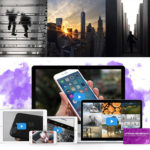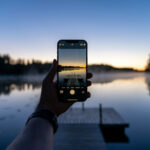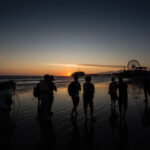
More Memory Cards
This is obvious on first appearances and does give you flexibility. Memory cards are small and easily portable. Their cost as well has fallen sharply over the last few years and the capacity of them has also increased. 8GB models are now appearing on the market. However whilst their cost has come down you may still need a large amount of them, they also seem to fill up at the most inconvenient time. The transfer rate from memory cards is also very slow when compared to say, USB 2 transfer rates, so after a day’s shooting expect a long time transferring the pictures to your computer.
Tethered Shooting

Transfer device
If you are away for several days, likely to take lots of pictures and don’t want to take your laptop with you there are now portable transfer devices available. You can plug you memory card into the device and it will transfer your data onto an internal hard drive. The size of the hard drive varies but is typically about 80GB. They have the advantage of capacity, being smaller than a laptop or notebook computer and some of the higher end models have a display on which you can review the pictures. If you want extra gadgets then this certainly should be on the wish list.
 Deleting!
Deleting!
Not used that often but very obvious! A certain proportion of pictures will probably be deleted or never used once taken. Typically there is something wrong with the composition of the picture or something wrong with the technical side, exposure, depth of field etc. If you get into the habit of deleting these pictures as soon as possible then vast amounts of space is saved. This can be a difficult one, the first problem is reviewing pictures on a small camera display is not the best war to critically review a picture (although in conjunction with a histogram display the obviously bad pictures can be identified). The other problem most photographers face is that this is rapid assessment of where they have done something badly – something no photographer will admit – and try to avoid.
Hybrid
Typically I use a hybrid approach to taking photographs. If I’m out for a day’s shooting I will endeavour to delete as many pictures as possible as I go. Then, if I stop for lunch I will transfer the pictures over to a laptop at the same time. This ensures that I get into the habit of not transferring large amounts of files I will never use and probably just sit there gathering (metaphorical) dust on the hard drive.
Which ever method you use, don’t let the technology get in the way of creating that perfect picture and have fun doing it!
Paul Klein lives and works in Loughborough. He is currently undertaking a project to photographically document places and events in Loughborough. The work to date can be seen at Photographs of Loughborough.
Like This Article?
Don't Miss The Next One!
Join over 100,000 photographers of all experience levels who receive our free photography tips and articles to stay current:







Leave a Reply